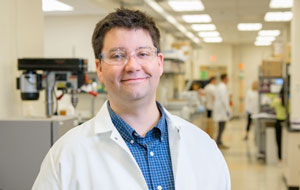| Dec 05, 2018 |
Breakthrough in blood vessel engineering
|
|
(Nanowerk News) When someone has a deadly disease or sustains a life-threatening injury, a transplant or graft of new tissue may be the best -- or only -- treatment option. Transplanted organs, skin grafts and other parts need blood vessels to bring oxygen-rich blood their way, but for tissue engineers and regenerative medicine experts, making a functional blood vessel network within large tissues in the laboratory has long been a major challenge.
|
|
Now, a research group at the University of Delaware has pioneered methods to grow a self-assembling, functional network of blood vessels at a size relevant for human use. Jason Gleghorn and his colleagues are the first to make this system work at this scale, and their results were recently published in the journal Biomaterials ("Fabrication of centimeter-scale and geometrically arbitrary vascular networks using in vitro self-assembly").
|
 |
| Jason Gleghorn, assistant professor of biomedical engineering.
|
|
Gleghorn, an assistant professor of biomedical engineering at the University of Delaware, studies how the embryo builds tissues and organs during development with the goal of using this knowledge to define new regenerative medicine strategies. While other groups have made blood vessel networks that span millimeters in size, the UD system works across centimeter scales, necessary for functional tissue replacement. With more development and refinement, Gleghorn's microfluidic system could someday be utilized to grow blood vessels for tissue and organ transplantation into humans.
|
How to build blood vessel networks
|
|
The team embedded human blood vessel cells into a gel made of collagen, a protein found in connective tissue such as skin and joints. The goal was to determine the physical conditions necessary to make the cells grow, multiply and connect with each other so that a network of blood vessels assembled itself.
|
|
Making blood vessel networks is tricky business because the system doesn't always behave how investigators expect. During his doctoral training, Gleghorn was part of the first team that developed techniques to create patterned blood vessel networks for tissue engineering using microfluidic techniques.
|
|
"As an engineer, we can say we think the cells need to be this far apart or the vessels need to be a certain size and spacing," Gleghorn said. "We can create a very precise environment and structure for the cells, but the problem is that biology doesn't work that way. The cells remodel everything. They change shape and size and push and pull on each other and the materials they are embedded in to rearrange our 'perfect' home that we think they need. The reality is we need to design systems that will encourage cells to remodel themselves and their environment to generate a functional tissue."
|
|
Instead, Gleghorn's group asked: "What is the fundamental initial starting point of the system that we need, and then can we kick it in the right direction to get it to evolve and build its own architecture similar to the way your body does it during development?" he said.
|
|
For one, using a powerful confocal microscope at the Delaware Biotechnology Institute, the group found that the density, or stiffness, of the collagen gel affected how the cells suspended within it behaved, ultimately affecting the size and connectivity of the vessels.
|
|
"It looks kind of like the holiday dessert with fruit suspended in Jell-O," said Gleghorn of the cells in the collagen gel. "You have a bunch of cells randomly distributed throughout the volume of the gel, and if they are sparsely distributed, it gets very hard for them to talk to each other and form connections to form vessels. The languages they use are chemical signals and physical forces." The key is to find the sweet spot of stiffness, stiff enough so that neighboring cells can interact with the material and each other, but not so stiff that the cells can't move.
|
|
The team also found that by perturbing their system in a specific way, they could affect the size and shape of the vessel networks under assembly.
|
|
"From larger vessels to much smaller microvessels, which are really hard to make, we can now tune the vessel network architecture with the initial starting parameters," said Gleghorn. This means that the new system could have applications from forming larger vessels deep within the body to tiny capillaries, the teeny vessels in your fingertips.
|
|
Gleghorn's team also found that their lab-grown blood vessels were perfusable, suggesting that blood could flow through them without leaking out of the vessels into surrounding gel. The vessel networks can also form throughout a variety of shaped gels, meaning that this system could be useful for building blood vessel networks in tissues with complicated shapes, such as the meniscus cartilage that pads your knees or a large skin graft for burn patients.
|

